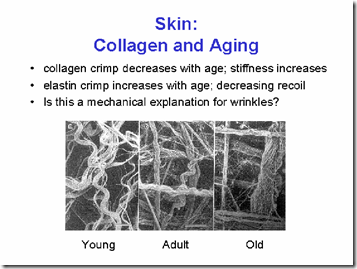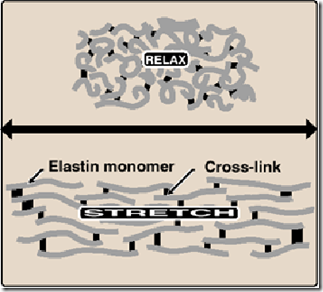4 types of tissues in body:
- Epithelial tissue
- Muscular tissue
- Nervous tissue
- Connective tissue
Connective Tissue
- Specialized connective tissue
- blood
- bone
- cartilage
- existing within many joints
- composed of specialized cells
- chondrocytes
- produced large amount of extracellular matrix
- collagen fibres
- ground substance (rich in proteoglycans)
- elastin fibres
- 3 types of cartilage
- Elastic cartilage
- Hyaline cartilage (articular cartilage)
- type 2 collagen
- rich in collagen & proteoglycan
- hard, translucent
- covers end of bones
- age related changes (degeneration, eg. osteoarthritis)
- fibrillation of the articular surface
- decrease in the size and aggregation of proteoglycans
- increased collagen crosslinking
- loss of tensile strength
- stiffness
- Fibrocartilage
- Component of CT consists of
- cells
- matrix (see below)
- composition & ratio determines the type of CT
2 classes of macromolecules that make up the extracellular matrix of CT
- Glycoaminoglycans (GAGs)
- unbranched polysaccharide chains composed of 2 repeating dissacharide unit
- sugars
- N-acetylgalactosamine
- N-acetylglucosamine
- Uronic acid
- occupy large amount of space in extracellular matrix
- it forms hydrated gels, thus enables them to withstand
compressive forces - hydrophilic & –vely charged
- 4 types of GAGs
- Hyaluronic acid
- Chondroitin sulphate
- Heparan sulphate
- Keratan sulphate
- *see proteoglycan below
- Fibrous proteins
- structural
- collagen
- elastin
- adhesive
- fibronectin
Proteoglycans
- Proteoglycan are GAGs
- except hyaluronic acid attached to the protein
- Function
- Regulate activities of signalling molecules
- GAG portion acts as sieve
- select molecules according to size and charge
- Acts as cell surface receptors
- Form huge polymeric molecules in cartilage or basal lamina
Collagen
- most abundant protein
- main protein in CT
- organised into insoluble fibres of great tensile strength
- suits its function as
- component of CT (eg bone, tendon etc)
- While in some tissues, like extracellular matrix, its dispersed as a gel
Structure
- long, rigid structure
- composed of 3 interwoven α-polypeptide chains
- tripeptide
- -Gly-X-Y- [ (-Gly-Pro-Hyp-)333 ]
- X: Proline
- Y: Hydroxyproline/Hydroxylysine
- held together by hydrogen bonds
Types
Different combinations of α-polypeptide chains form different types of collagen.
Type 1: (α1)2α2 , Type 2: (α1)3
Types:
- Fibril-forming collagen
- typical rope like structure
- Network-forming collagen
- forms a 3D mesh
- Fibril-associated collagen
- Binds to collagen fibrils and extracellular matrix
Synthesis
- Hydroxylation of proline and lysine
- important in stabilizing the structure of collagen
- hydroxylated residues appear only after collagen polypeptides are synthesise
- enzyme that converts Pro to Hyp is prolyl hydroxylase
- requires ascorbic acid (Vit C) to maintain its enzymatic activity
- Hyp confers stability upon collagen
- Glycosylation
- glucose or galactose are sometimes attached to the hydroxylysine residues
Degradation
- Collagen are dynamic and constantly undergo remodelling
- in response to growth/injury
- Accomplished by a family of collagenases
- cleave intact collagen fibres into smaller fragments
- these fragments can be phagocytosed and degraded by lysozyme to their constituent amino acid
Diseases
- Rare heritable disorders of collagen
- amino acid substitution/deletion in collagen polypeptide
- deficiency in particular type of collagen
- abnormal activity of collagen processing enzyme
- Scurvy
- deficiency of ascorbic acid
- required by prolyl hydroxylase
- skin lesion
- blood vessels fragility
- Ehler’s Danlos syndrome
- heterogeneous group of connective tissue disorders
- inheritable defects in the metabolism of collagen molecule
- Disorders:
- Deficiency of enzymes like lysyl hydroxylase
- Mutations in amino acid sequence
- most commonly type III collagen
- Characterised by:
- stretchy skin
- loose joints
- Osteogenic Imperfecta
- also known as ‘Brittle Bone syndrome’
- easily bend & fracture
- retarded wound healing
- mutation in either gene
- alpha 1
- alpha 2
- mutation results in abnormal triple-helical conformation
Collagen & Aging
Collagen Theory of Aging
- with age, collagen gets older
- old collagen gets stiff and not as flexible
- causing problems such as
- hypertension (vessels cant expand enough)
- organs malfunction (stiffness)
- hinders metabolic reaction
Wrinkles
- Due to changes in
- reduced collagen
- decreased protein synthesis
- affect collagen type 1 & 3 in dermis
- reduced elastin
- general atrophy in extracellular matrix
- due to reduced fibroblasts
Elastin
- CT with rubber-like properties
- Found in
- lungs
- blood vessel walls
- elastic ligaments
- Structure:
- small non polar aa composition
- valine
- glycine
- alanine
- lysine & proline (but little hydroxylation)
- Elastase enzyme (arise from neutrophil)
- breakdown elastin
- α1- anti-trypsin prevents elastase action
- deficiency will lead to emphysema
- degradation of alveolar walls in lungs












The skin is the most visible part of the body and you need to take good care of it. However, there are times when you have unsightly moles, warts, and skin tags. These are skin lesions which can now be removed through various methods. It doesn’t really matter if your skin is white, pinkish, brown, or black; what matters is how you care for it and there shouldn’t be any skin lesions to affect your overall look. ^
Most recently released post coming from our personal web page
<'http://www.healthmedicinelab.com/earache-tratment/